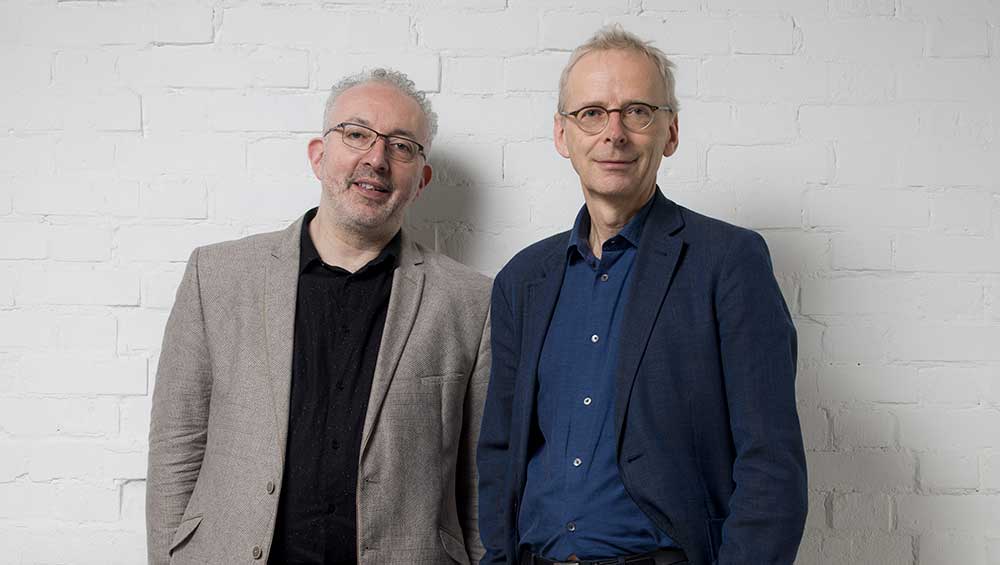
James Lingwood and Michael Morris. Photo: Tom Oldham, 2015.
by VERONICA SIMPSON
As directors of Artangel, a commissioning body and agency for the creation of art outside institutions, James Lingwood and Michael Morris enabled the career-defining moments of many artists who have gone on to be leading figures in the UK and internationally. Rachel Whiteread was relatively unknown when House, a concrete cast of the interior of a three-storey Victorian terraced home scheduled for demolition, secured her the Turner Prize in 1993. Michael Landy’s Break Down (2001) saw him deconstructing and dismantling all 7,227 of his possessions in the windows of the C&A department store in Oxford Street, London, for an entranced, if baffled, audience of more than 50,000 passersby.
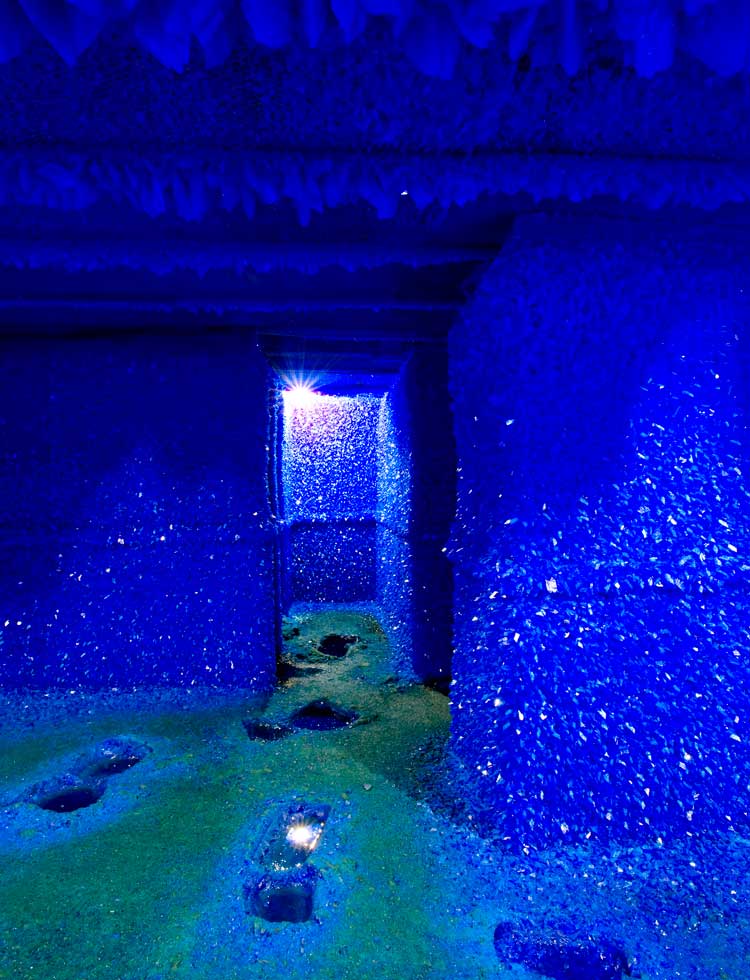
Roger Hiorns, Seizure, 2008. Commissioned and produced by Artangel. Photo: Marcus J Leith.
Lingwood and Morris’s strategic pairing of artworks with place – whether an abandoned warehouse in east London or a post-nuclear testing site in Suffolk – enabled artists to speak more directly to issues prevalent in our times. In Seizure (2008-10), Roger Hiorns took a mid-20th-century flat on a south-east London council estate, which was due to be demolished, and filled it with 90,000 litres of copper sulphate solution, transforming it into a blue crystal cavern. This seemed to articulate something profound about what and who we value in our cities. Jonathan Jones in the Guardian described it as “one of the truly worthwhile and significant moments of modern British art”.
For American artist Taryn Simon’s powerful exploration of grief, An Occupation of Loss (2018), the duo found her a vast underground cavern, an unfinished opera house in Islington, north London, which Simon filled with a community of professional mourners, who chanted, sang, played and enacted mourning rituals from all over the world. The piece was accompanied by documentation showing all the visas and paperwork that had been required to bring these people into the UK, speaking volumes about our shared humanity and the artifice of national boundaries.
Reading jail was opened to the public for the first time in decades for another landmark exhibition, this one inspired by Oscar Wilde’s incarceration there. Inside: Artists and Writers in Reading Prison (2016) eloquently articulated isolation and ostracisation in the works of artists including Marlene Dumas, Nan Goldin, Richard Hamilton, Roni Horn, Wolfgang Tillmans and Steve McQueen.
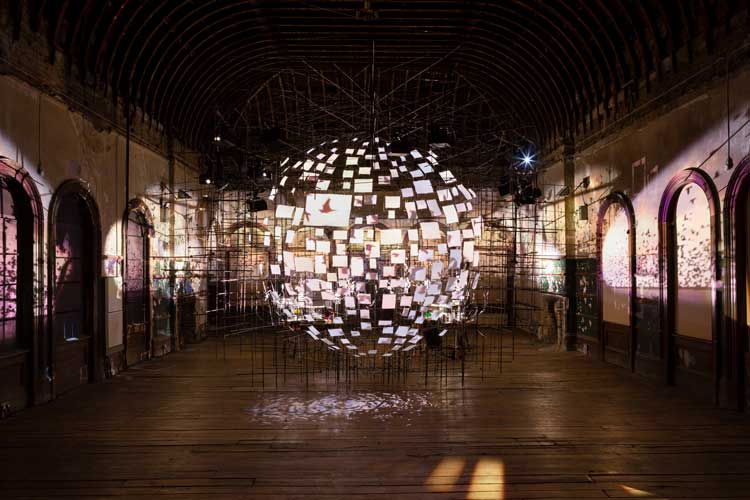
Sarah Sze, Metronome, 2023. Commissioned and produced by Artangel. Photo: Thierry Bal.
As 2023 drew to a close, the duo signed off on their last commissioned project, Sarah Sze’s Metronome (2023), leaving this innovative organisation fully in the hands of new director Mariam Zulfiqar (who joined in 2022). We asked them to look back over their 30 years with Artangel and share what prompted, shaped and influenced their mission to make contemporary art more exciting, relevant, ambitious and entertaining.
We met them at the offices of Tank magazine in London, for which they are creating a podcast series.
Veronica Simpson: Let’s start at the beginning. What were your backgrounds before you got involved with Artangel?
James Lingwood: My background was in visual arts, contemporary art. I had been working as a curator of exhibitions at the ICA in London which, in the 1980s, was very dynamic. It was a crucible for lots of interesting artists, writers and music.
Michael Morris: I did the ICA’s live events.
JL: In the late 80s, both of us had become interested in how artists could work in different kinds of spaces because of the nature of the work, the scale of the work. The institutional spaces then were very restrictive. And the ideas and aspirations of artists had outgrown the kind of containers, the frameworks in which pretty well any cultural institution in Britain operated at that time.
MM: We worked under Bill McAlister (director of the ICA from 1977-90) and he was extremely supportive of the idea that the programme could exist beyond the walls of the ICA. Quite a lot of the live events I was doing at the end were in different parts of London. I remember La Fura dels Baus, a Spanish theatrical group from Barcelona. We put them in a shed that later became the runway at London City Airport. We did the first epic work by Laurie Anderson, United States parts 1 to 4, which we staged in the Dominion theatre in 1983.
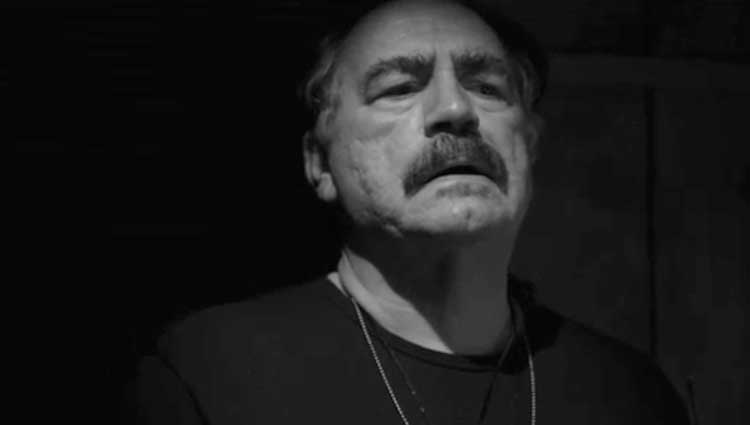
Brian Cox in Fiona Banner's Heart of Darkness, 2012. Commissioned and produced by Artangel. Copyright © 2012. The Estate of Orson Welles.
VS: When I came to live in London in 1985, the ICA felt like the centre of contemporary culture.
MM: It’s where you went to meet people, to see things you wouldn’t see anywhere else, where international work was integrated with British work.
JL: British culture at that time was pretty insular. And the ICA, together with the Whitechapel and occasionally the Hayward, were the few places where you could see international, contemporary work.
VS: So, you jumped ship wanting to do more of that kind of thing.
MM: We both jumped ship for the same reasons, but at different times. Artangel existed in a different form, and we were encouraged to put forward a proposal for taking it over, which we did. And there was very little infrastructure.
JL: I think we said that we’d like to look at it for three months and see if we could imagine a way forward. And what I think helped us imagine a way forward was talking to artists. For artists, the idea of an agency that offered an open and non-prescriptive space was very attractive.
MM: It took less than three months to discover that there were no real resources, and no board of trustees constituted in the way that we made sure it was eventually constituted.
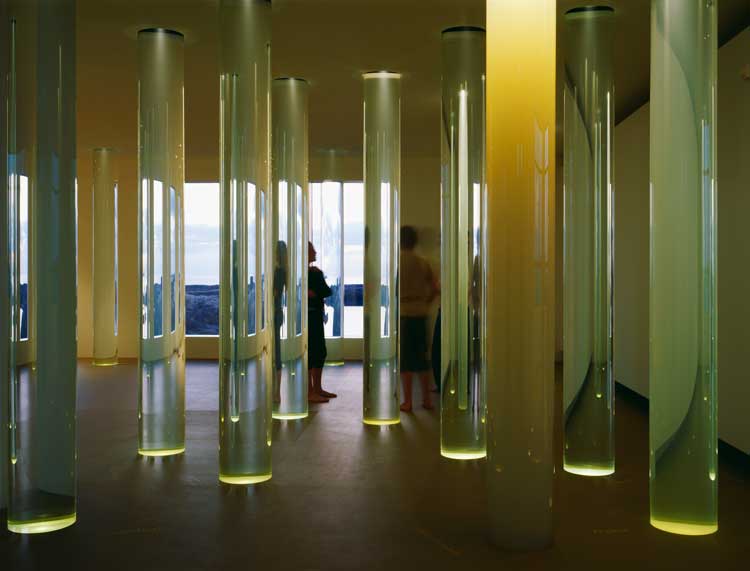
Roni Horn, VATNASAFN/LIBRARY OF WATER, 2007. Commissioned and produced by Artangel. Photo: Stefan Altenburger.
VS: What were your first projects?
JL: We worked on an exhibition at the Hayward gallery called Doubletake (with Artangel commissioning additional sculptures in the public realm). We commissioned a sculpture by a German artist called Stephan Balkenhol, which provided our first mini controversy. He made a life-sized wooden figure of an ordinary caucasian male, improbably dressed, on a buoy (Figure on a Buoy, 1992), which we placed in the river. It was our first of many acts of persuasion with different authorities whose regulations we always have to navigate. We had to get the agreement of the Port of London Authority to put this buoy in the Thames. They were somewhat sceptical about the idea, but we convinced them. There was another sculpture on the Southbank, Monument (1992) by Juan Muñoz. But Stephan’s sculpture caused a lot of interest. About a week after it opened, somebody on a pleasure cruise, who had had a few drinks, thought it was a figure in distress and dived in to try to save it. That was a quick end to our first public sculpture. It had to be removed to a safer location on a large pontoon.
MM: At the time, it was just James and me, and a part-time assistant we had for a couple of days a week, in a tiny office on New Oxford Street in central London. At the same time, we began to talk to (dancer and choreographer) Michael Clark and made a project in a depot at King’s Cross, now Coal Drops Yard, with Leigh Bowery, Michael and Michael’s mother, Bessie. The opening sequence was Michael being reborn from Bessie to the sound of T Rex’s Cosmic Dancer. It was a wonderful show, called Michael’s Modern Masterpiece (which later became known as “Mmm”). It was an important project, partly because we took a big risk on it. If the audiences hadn’t shown up, I don’t think we’d have stayed at Artangel.
JL: It was a ticketed event, in the hinterland of King’s Cross, next door to Bagley’s nightclub, when the area was a very different place. Although it was in the centre of London, it was taking people to unfamiliar territory. It charged the atmosphere of the piece. When something works, that’s what you feel has happened. It creates a certain energy around the place.
MM: I think we realised that the journey to the site was part of the experience of the work, and that’s something we always maintained throughout the following 30-odd years: that sense of adventure before you arrived. People got lost or were 20 minutes late most nights. Those are the two projects that gave us the confidence that we could work across disciplines. It wasn’t really a commitment to a particular art form, but to an idea, regardless of the form of its expression ... And realising that the choice of the location, the right location deepens the meaning of the work. You can’t take one away from the other, the idea and the place are linked always. It was possible to transpose some of the moving image work to a different location, and we did that later through the Artangel Collection, Works in Moving Image. But most of the sited works were one-offs. Michael Landy’s Break Down in 2001 and Jeremy Deller’s The Battle of Orgreave in the same year were projects that couldn’t be repeated: they were site specific and moment specific.
.jpg)
Rachel Whiteread, House, 1993. Commissioned and produced by Artangel. Photo: Stephen White.
VS: Did you think at any point that you were making public art, because the work you have done has been hugely influential in this field?
JL: Some of what Stephan Balkenhol was doing, and Juan Muñoz to an extent, worked within the idiom of the memorial, of specific public sculpture. So, there was a sense in which that language was there to be reworked. And that kind of work needed an open or public space. The same would be true of Rachel Whiteread’s House. That was within the language of the memorial – anything from the cenotaph to the cemetery. So, for sure, that was part of the field of possibilities, but we didn’t describe ourselves as a public arts organisation. Most people would associate public art with art that’s outside, which can be encountered by anyone and becomes part of the fabric of the city. And (with many Artangel works) you were being invited to go into an interior world.
VS: How did the art world respond to what seems like a very punk approach, very multidisciplinary, appealing to different audiences?
MM: It didn’t matter. It just reflected our enthusiasms, passions and interests. We didn’t have a manifesto. Looking back, you can see through-lines. I’m thinking of a talk we did about 25 years in, called No Fixed Address, which grouped some of the projects under materials. Some were quite physical, such as concrete; another was family. And the home – we did a lot of projects to do with domestic reality.
JL: That became a very strong, sporadic through-line. Classically, that would be Rachel Whiteread’s House and Roger Hiorns’ Seizure.
MM: Sometimes artists would come with very specific ideas. Rachel came to us with the notion of casting a terraced house. And Jeremy Deller responded to our first open call with an idea to recreate the Battle of Orgreave. There were times when the project was much more elusive than that. We’d start with nothing, not a space, not an idea, but a conversation. Sometimes that would take different forms. But there was no one way that projects arrived.
VS: But each project demanded very different things of you, logistically as well as operationally.
MM: It was about starting from the ground up every time.
JL: One of the strengths of the offer was that we weren’t really starting off by saying: “This is the container in which your ideas need to exist.” It’s exploring the idea and then thinking where and how can they be most fully expressed.
MM: It was more important to start off with the sense that we knew nothing. Each project was about discovering something that wasn’t related to a previous project. We used to develop several projects at a time, not quite knowing which was going to reach the finish line first. Because there were two of us, we were able to do that. James would be developing a project while I was at the coalface of production, two people with overlapping interests but also individual interests, which changed over the years. My background was in live performance, James’s was in the visual arts, but that became much more blurred towards the end. Taryn Simon’s background is in the visual arts, but An Occupation of Loss was not straightforward. It was an extraordinary experience. The circuitous route to making it happen was very challenging.
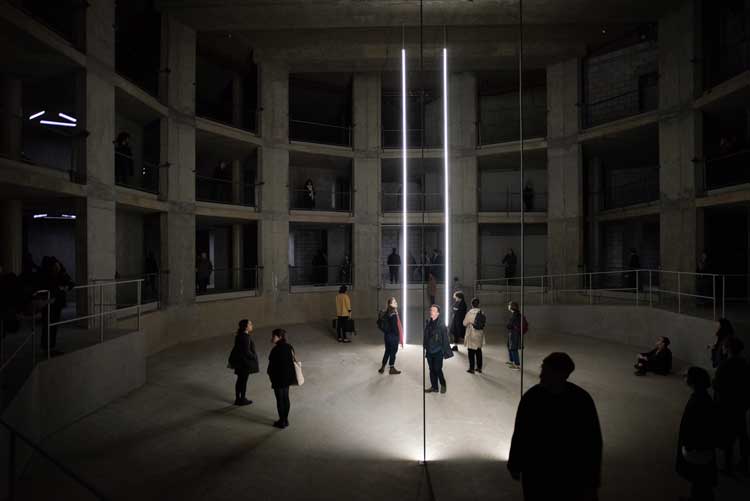
Taryn Simon, An Occupation of Loss, London, 2018. Commissioned and produced by Artangel. Photo: Hugo Glendinning.
VS: I read that it took seven years to bring the work to fruition.
MM: Like many projects, you find the perfect site, but then we weren’t able to use it, so we had another series of hurdles to navigate in order to use it. It was an unlikely half-constructed underground opera house in Islington. It was like something in a dream. Even people who lived very near had no clue it was there. You felt you were in some strange underworld.
VS: At the point when you realise this project is magnifying incrementally in bureaucratic, diplomatic and logistical complexity – such as having to secure visas and passports for all the participants in that work – what do you do? Do you have fixers?
MM: Yes, we had fixers that Channel 4 used. We knew we had to find mourners in the same way that somebody in Uzbekistan would find somebody to be interviewed for a political event that’s going on there. These fixers were used to finding the right people and they turned their hand to professional mourners. There are a lot of professional mourners. We tried to balance the most distinctive, the ones who showed the most contrast.
VS: Which of your projects have been the most challenging?
JL: On the Richter scale of challenge, that was probably quite high up.
MM: On all the projects, there is a moment when James and I would share a concern that it might never happen. And that one probably was the closest we got to admitting defeat.
JL: There have been projects that didn’t see the light of day – not that many, maybe a dozen.
VS: Which isn’t bad, given that you have produced at least 125 works.
JL: The art of producing is the art of persuasion…
MM: And timing. Knowing when to go in hard and knowing when to hold back and wait.
JL: There have been one or two occasions when our capacity to persuade wasn’t really the issue. One project that I’m not sure we should have done is Catherine Yass’s High Wire. It was a tightrope walk on a wire stretched between the tops of two high-rise buildings at Red Road, an estate in Glasgow. For Catherine, the idea was to film the tightrope walker Didier Pasquette. We tried to get permission but were told we couldn’t do it. I remember going to a meeting in Glasgow with the head of police and the head of civil authorities, and telling them they didn’t have the right to prevent us.
VS: Because the air between buildings is free space?
MM: Yes, but the issue was to do with Pasquette’s refusal to have any kind of safety harness.
JL: And no insurance. And, actually, something extraordinary came out of it, which was a film about failure and fear. He only got a short way along the wire and then reversed. In retrospect, it probably would have been better if we hadn’t been so set in our persuasion because someone was at serious risk. All the collateral damage – for the artist, for Artangel, for other people –doesn’t bear thinking about.
MM: It’s very hard to describe the feeling of being on the ground and watching this happen. Even when I think of it now, I feel sick. It was a terrible experience, but it was a great film.
VS: When it goes right, what are the rewards?
JL: There’s something particularly rewarding about a work that takes on a life of its own. It exerts a magnetic pull and becomes a talking point when it resonates beyond what you might have hoped for. But there are many other rewards. The rewards are working closely with an artist and feeling that they have pushed their work to a place they haven’t gone before. And that it was beautifully realised, whether it had a few hundred visitors or a few thousand.
MM: The reward is also the relief that it happened. But satisfaction is another thing, because I find the feeling of satisfaction is very transient, it doesn’t last very long.

Michael Landy, Break Down, 2001. Commissioned and produced by Artangel. Photo: Hugo Glendinning.
JL: There are certain projects, such as Break Down, which have the capacity to turn sceptics into believers. You would have had a lot of people going to Break Down who wanted a bit of a laugh. What was interesting was this sense that if you strip away trying to name it as something and people come to terms with the experience, they realised that Landy was connecting with something deep within them: our relationship to possessions; how do we construct our identity? It did resonate in ways that we couldn’t have anticipated. And it still does today.
MM: The important thing is that none of these projects is ever cynical. They are always made with integrity, no cynicism at all.
VS: Who is the intended audience? There is a perception in some areas that the work is largely intended for an art world audience.
MM: I hope not. The art world audience was for us the least interesting audience. Because we also did projects in other arenas. The art world is very London based, very metropolitan. But when we did a project in Reading prison, most people who came were from Reading – more than 60,000 people who were curious about a building they had never before had access to.
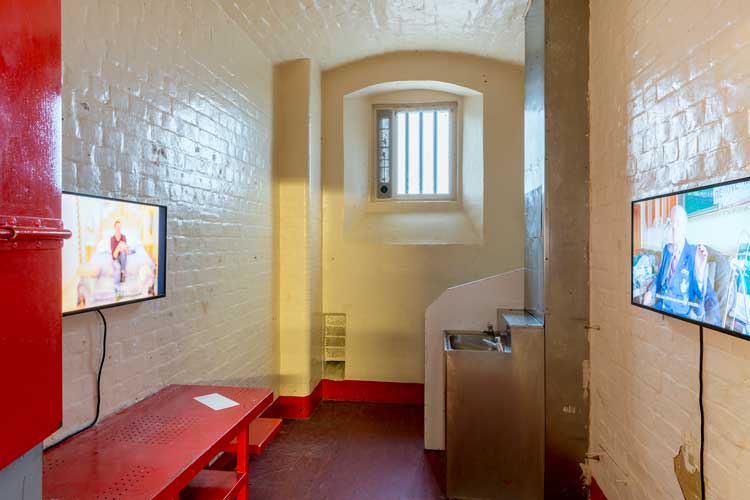
Artists and Writers in Reading Prison, 2016. Commissioned and produced by Artangel. Photo: Will Eckersley.
VS: To me this is what makes that work public art, because the public is invited and enticed in a way that the stereotypical museum-goer wouldn’t be.
MM: The work doesn’t exist until the public are part of it; it really comes alive only when the public engages.
VS: The satisfaction you get from recounting these projects is palpable. It must be an amazing body of work to look back on.
MM: There’s nothing I would prefer to have done over the last 30 years.
VS: There is a very good digital archive on your website. When did it become necessary to have some record of the work?
JL: The necessity to document and record was inscribed from the beginning. If you know that works you’re involved in are going to be ephemeral, you need to have them recorded one way or another because then there are two audiences. There’s the audience who may have experienced it live, and those who would never have experienced it.
VS: What do you feel are the impacts of the kinds of work and concepts of performance that you have encouraged and enabled through Artangel? The way people expect to experience art has changed radically over the last 30 years. Seeing mind-blowing performances in unusual places has been normalised. Theatre companies such as Punchdrunk have taken that baton and run with it, for example.
MM: Punchdrunk director Felix Barrett was kind enough to acknowledge that seeing HG [a 1995 artwork by Hans Peter Kuhn and Robert Wilson in tribute to HG Wells’ Time Machine] in Clink Street vaults was the seed that led him to grow Punchdrunk. He was a teenager on a school trip at the time he saw it, and it never left him. We did use the word immersive then, without it being a genre of art.
JL: I would say that from the early 90s, gradually over the next two decades, site specific work became its own orthodoxy.
VS: Given the changes you have seen over 30 years, what do you feel is the purpose and meaning of art in these difficult times? I came across a wonderful quote from the poet Michael Longley: “I don’t altogether like the idea that art can be a solace … that … civic commotion … might be good for art … I like the Aristotelian notion of catharsis … what art can do is to tune you up … Good art, good poems [are about] making people more human … more intelligent … more emotionally pure than they might otherwise be.”
MM: I think art is more than consoling. It’s an invitation to understand more about yourself and the world, which is a constantly shifting relationship. It’s certainly shifted in the time that we’ve been working together through Artangel. A lot is expected of artists now.